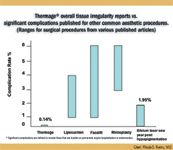- Case-Based Roundtable
- General Dermatology
- Eczema
- Chronic Hand Eczema
- Alopecia
- Aesthetics
- Vitiligo
- COVID-19
- Actinic Keratosis
- Precision Medicine and Biologics
- Rare Disease
- Wound Care
- Rosacea
- Psoriasis
- Psoriatic Arthritis
- Atopic Dermatitis
- Melasma
- NP and PA
- Skin Cancer
- Hidradenitis Suppurativa
- Drug Watch
- Pigmentary Disorders
- Acne
- Pediatric Dermatology
- Practice Management
- Prurigo Nodularis
- Buy-and-Bill
Article
Post-radiofrequency
New Orleans — Subcision with autologous fat transfer can safely correct surface irregularities that have been a rare complication of noninvasive radiofrequency treatment (ThermaCool ?, Thermage Corp.) without negating the tissue tightening and contouring benefits of the procedure, said Rhoda S. Narins, M.D, a New York dermasurgeon, at the 63rd Annual Meeting of the American Academy of Dermatology here.
New Orleans - Subcision with autologous fat transfer can safely correct surface irregularities that have been a rare complication of noninvasive radiofrequency treatment (ThermaCoole™, Thermage Corp.) without negating the tissue tightening and contouring benefits of the procedure, said Rhoda S. Narins, M.D, a New York dermasurgeon, at the 63rd Annual Meeting of the American Academy of Dermatology here.

"These contour defects are largely preventable with the use of properly customized and administered radiofrequency treatment to avoid tissue overheating," Dr. Narins says. "However, I have found it is possible to use this surgical intervention and help patients who have not responded adequately to more conservative measures."

When performing the fat transfer, Dr. Narins uses tumescent anesthesia at the donor and recipient sites and harvests the fat gently using a 10 cc syringe and Coleman extractor. After centrifuging the material for one minute, the infranate and oily supranate are discarded, extra supranate is wicked off, and the fat is transferred into 1 cc syringes through a female-to-female adapter.
A baby Toledo cannula is used to undermine and destroy the fibrous septa prior to fat transfer, and the latter is performed through an incision made using an 18-gauge NoKor needle. The 1 cc syringes of fat are attached to a Coleman injection cannula, which is then inserted into the incision. Unused fat is frozen for later use.
Rare and getting rarer Dr. Narins notes the risk of surface irregularities has been almost eliminated with adherence to newer, more conservative treatment guidelines from the manufacturer that are designed to minimize tissue overheating.
Those recommendations, which were introduced in January, 2004, recommend use of multiple passes, more moderate settings, lower pain scores, the new fast tip and no injected local anesthetic.
Between August 2002, and August 2004, the incidence of surface irregularities associated with the radiofrequency procedure was 0.14 percent, and there was a noticeable spike between October, 2003 and February, 2004. Between August, 2004 and the present, the rate has declined to 0.04 percent.
"The fact that 100 percent of the reported contour irregularities are accounted for by 6 percent of physicians performing the radiofrequency procedure suggests the occurrence of this complication is technique-related.
Interestingly, as well, 70 percent of the contour irregularities that have been reported developed in patients who underwent the radiofrequency procedure after being blocked with a local anesthetic or receiving IV sedation," she says.
Anesthesia's effects Avoidance of local anesthesia is critical because patient feedback on heat sensation is a key parameter for determining the treatment settings.
"Pain is a marker for tissue injury," Dr. Narins says.
It has also been suggested that tumescent anesthesia may alter tissue impedance.
Disclosure: Dr. Narins reports no financial interest in the material she discussed.





